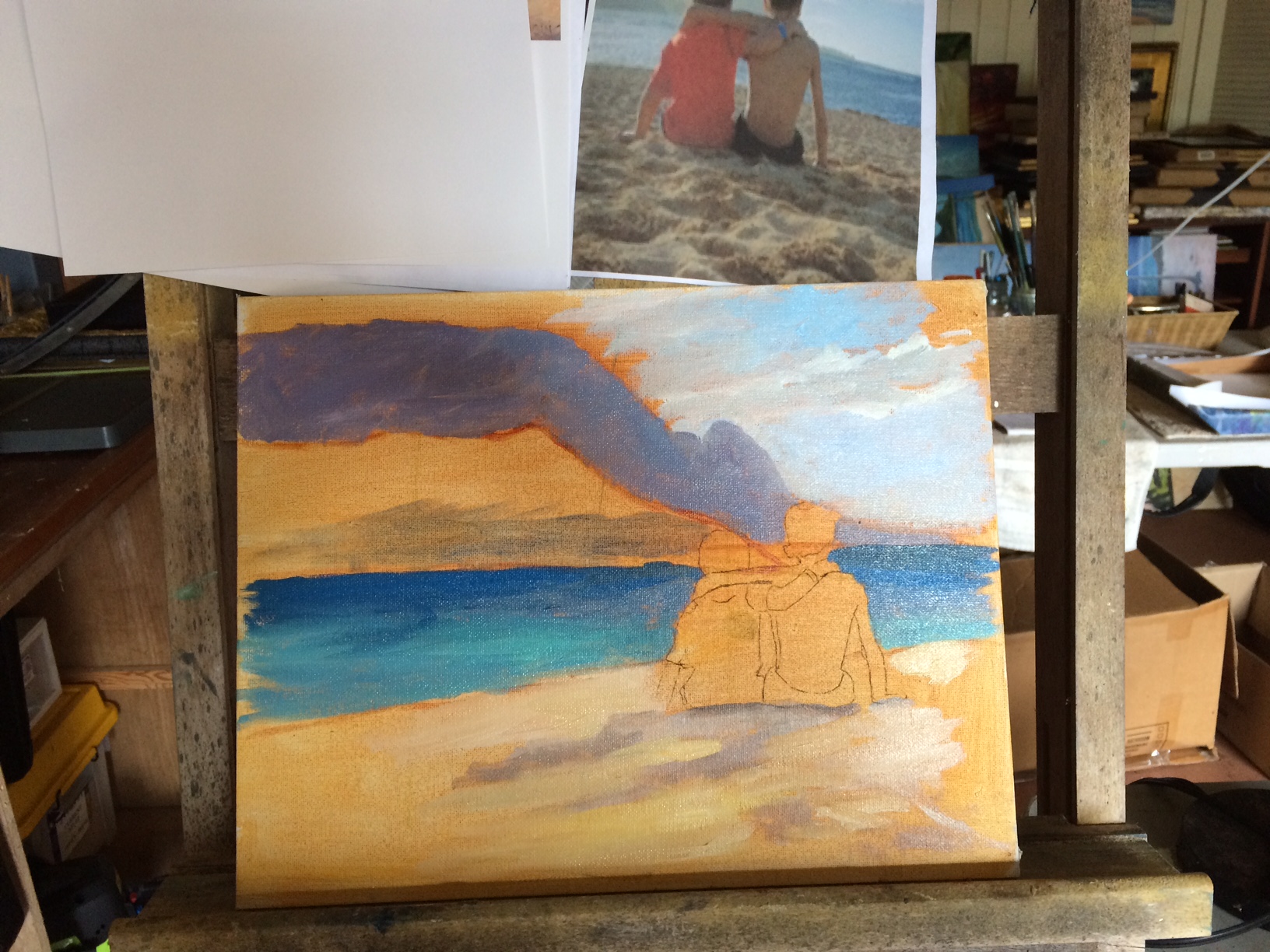
14 Jun Painting with our Values
Tale of the Day:
Painting Again!
I recently met for one session with a painter who had lost confidence in her painting. Dawn had barely painted in the last 2 years. She’d tried willpower and therapy and neither had helped her. This was her profession and her passion, so it was really important for her to get back her joy of painting. Dawn was a bright woman in her seventies who told me she’d been procrastinating working on a particular painting (pictured here) for nearly 5 months. Every time she attempted to work on this painting she heard this voice saying, “You’re doing everything wrong!” Now she was about to go to a conference and it was important to her to finish this painting beforehand, but even with the conference days away she still hadn’t brought herself to do the painting she wanted to do. She wanted to return to the joy of painting without hearing “you’re doing everything wrong,” and she wanted to regain confidence in her ability and talent.
When I met with Dawn over Skype I asked her to step back into the last time she’d attempted to paint, and listen to the voice saying “You’re doing everything wrong!” I asked her to pay attention to this voice, and then asked her, “Whose voice is it?”
She knew right away, “It’s the voice of a teacher. It cost me more than five thousand dollars to take an art workshop with him in Italy. I was in his workshop happily painting away in my painting trance-state, and out of the blue he shouted at me, ‘You’re doing everything wrong!’” She told me she’d tried envisioning the teacher and pushing him away, and using positive affirmations, neither of which had worked. Though many practitioners advocate these methods, positive transformation doesn’t usually come from attempting to ignore or override our experience, it comes from paying attention more completely.
“Great noticing,” I said, “so now that you clearly recognize the speaker of this voice, go ahead and see his face and the context he’s in—so that you can understand that what he’s saying comes from his unique point of view. I’m sure he has skills and insights, and also plenty of his own limitations. So as you hear this from him, go ahead and ask him if he would like to clarify his message. Often what gets communicated is pretty far from what was actually intended. So ask him, ‘Would you like to clarify your message to me?’ ”
“Yes,” Dawn responded, “He really meant to say, ‘Your color values are wrong and your drawing skills are lacking.’ ”
“Go ahead and thank him for clarifying his message to you. And now that you hear this information coming from him, you can decide whether any of it is worth paying attention to or not. A lot of art is quite subjective, so even though you may agree with his opinion on some things, there are other things you may have a different opinion about.”
“Well he is a really talented painter, and I admire his work a lot, that’s why I paid so much money to learn from him and why I lost so much confidence when he told me I was doing everything wrong!”
“OK, so it’s important to notice that he has certain skills you really admire, and so you have an opportunity to learn from those skills if you want, even if he’s a pretty lousy communicator at times. Because what he really meant to communicate was that he thinks your color values could be improved, and also your drawing skills.”
Dawn nodded.
“Are those areas that you also want to improve?”
“Yes, possibly. At least some things in certain ways.”
“Great, so you can notice which things you agree you want to improve, and which things you’re happy with as they are. Now go inside again and ask him, ‘What was your positive intention in telling me these possible improvements?’ Recognize that his positive intention may be for himself, or for you, or someone else.”
He says, “I wanted your attention so I can teach.”
“Great, thank him for this response, and ask him, ‘When you have my attention so you can teach, what does that get you that’s even more important?’ ”
“Then I have students that are skilled.”
“Thank him for this response, and ask him, ‘When you have students that are skilled, what does that get you that’s even more important?’ ”
“They will attract other students to take my courses.”
With each answer I invited her to thank the teacher and ask, “And what does that get you that’s even more important?” to which the answers were:
- “Then I’ll be more successful, more known, and make more money.”
- “I will feel good about myself.”
- “I will love myself.”
- “I can be kinder to others.”
“Isn’t that interesting,” I said. “It turns out that what he really wanted was to be kinder to others!
“So now that you’ve discovered that his positive intention was for himself—for his success and feeling love for himself—you can realize that it really didn’t have anything to do with you. It had to do with him wanting love for himself and ultimately wanting to be kinder to others. So ask him if he would like to speak to you in a new way that truly communicates his positive intention of wanting to be kinder to others?”
“Yes,” Dawn said. “His voice tone is much softer now, and now he’s pointing out things I’m doing well.”
“Great. And since he is an artist you admire, you may also want to invite him, at the times that are best for you, to also point out possible areas of improvement that you can take or leave depending on whether his suggestions fit with your values as an artist.”
She smiled and nodded and looked quite happy with this arrangement.
“Great, now imagine that specific time in Italy, and find out how it goes when he speaks to you in this new way that is really how he would have spoken to you if he’d had the resources to truly communicate his positive message.”
She continued to smile and nodded. “Very different. Good. It’s easy.”
“Now think of one of the times in the past when you used to hear, “You’re doing everything wrong,” and find out how it goes now with him speaking to you in this new way?”
“Wow, I actually feel like painting!”
“Great.” I invited her to imagine several other past situations to further test the change. They also went well, so I asked her, “Ask on the inside, ‘Is there any part of me that has any objection to him speaking to me in this new way going forward into the future?” She said no, so I invited her to imagine several future situations as further testing and to rehearse the change in the future situations where it will be of use to her.
“Of course the man in Italy may still have trouble communicating the way he truly wants to, but now this inner voice can translate for him,” I added. I guessed that she might still have interactions with the man in future courses or instructional videos, so I wanted to make sure she was prepared for future gruffness from him, even as she maintained this new positive inner voice as an ally. We ended the session, and that evening Dawn sent me this email with the below photos attached:
“Wow : ) thanks I almost finished it this afternoon this is the one I procrastinated for almost 5 months!!!!! : )”


Now it’s been two months, and Dawn just wrote me this a few days ago:
“Thanks, I’ve been doing some really excellent work over the last two months. I’m very pleased and relieved.”
You can view more of Dawn’s artwork on her website www.lundquiststudios.com
Tool of the Day:
Transforming inner critics into helpful allies
To explore this process on your own, visit this previous blog post and scroll down to the “Tools” section for the process steps.
Learn this process from Mark in an online webinar on Aug. 15th, from 7-8:30pm US Mountain Time.
Sign up for a session with Mark at www.markandreas.com or call 303-810-9611 for a free 15-minute consult.


Barrett Vickery
Posted at 16:16h, 25 JuneLove this story Mark, I’m glad Dawn was able to start painting again. It still blows my mind that we can cure ourselves and re-contextualize our problems through the use of thought and language. I love it!